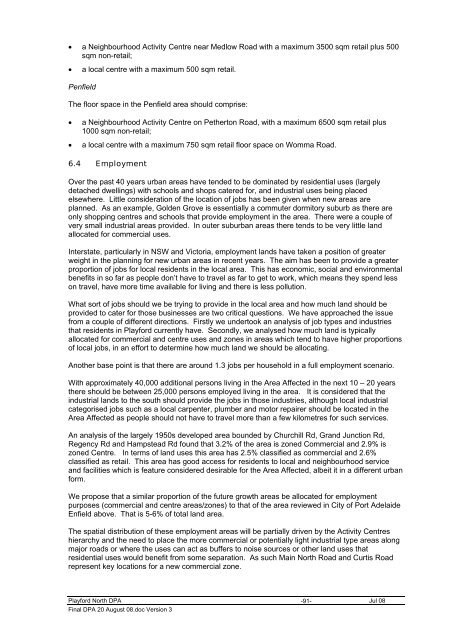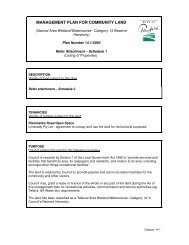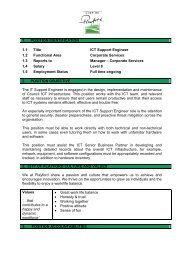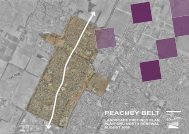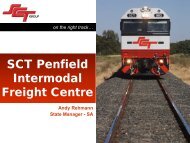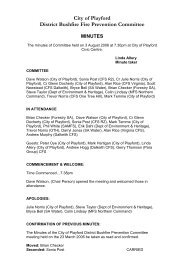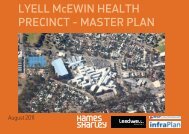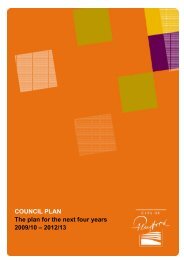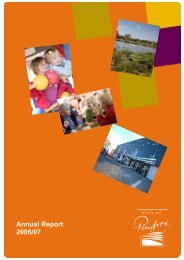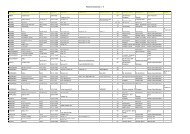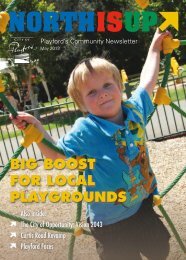Development Plan - City of Playford - SA.Gov.au
Development Plan - City of Playford - SA.Gov.au
Development Plan - City of Playford - SA.Gov.au
You also want an ePaper? Increase the reach of your titles
YUMPU automatically turns print PDFs into web optimized ePapers that Google loves.
• a Neighbourhood Activity Centre near Medlow Road with a maximum 3500 sqm retail plus 500<br />
sqm non-retail;<br />
• a local centre with a maximum 500 sqm retail.<br />
Penfield<br />
The floor space in the Penfield area should comprise:<br />
• a Neighbourhood Activity Centre on Petherton Road, with a maximum 6500 sqm retail plus<br />
1000 sqm non-retail;<br />
• a local centre with a maximum 750 sqm retail floor space on Womma Road.<br />
6.4 Employment<br />
Over the past 40 years urban areas have tended to be dominated by residential uses (largely<br />
detached dwellings) with schools and shops catered for, and industrial uses being placed<br />
elsewhere. Little consideration <strong>of</strong> the location <strong>of</strong> jobs has been given when new areas are<br />
planned. As an example, Golden Grove is essentially a commuter dormitory suburb as there are<br />
only shopping centres and schools that provide employment in the area. There were a couple <strong>of</strong><br />
very small industrial areas provided. In outer suburban areas there tends to be very little land<br />
allocated for commercial uses.<br />
Interstate, particularly in NSW and Victoria, employment lands have taken a position <strong>of</strong> greater<br />
weight in the planning for new urban areas in recent years. The aim has been to provide a greater<br />
proportion <strong>of</strong> jobs for local residents in the local area. This has economic, social and environmental<br />
benefits in so far as people don’t have to travel as far to get to work, which means they spend less<br />
on travel, have more time available for living and there is less pollution.<br />
What sort <strong>of</strong> jobs should we be trying to provide in the local area and how much land should be<br />
provided to cater for those businesses are two critical questions. We have approached the issue<br />
from a couple <strong>of</strong> different directions. Firstly we undertook an analysis <strong>of</strong> job types and industries<br />
that residents in <strong>Playford</strong> currently have. Secondly, we analysed how much land is typically<br />
allocated for commercial and centre uses and zones in areas which tend to have higher proportions<br />
<strong>of</strong> local jobs, in an effort to determine how much land we should be allocating.<br />
Another base point is that there are around 1.3 jobs per household in a full employment scenario.<br />
With approximately 40,000 additional persons living in the Area Affected in the next 10 – 20 years<br />
there should be between 25,000 persons employed living in the area. It is considered that the<br />
industrial lands to the south should provide the jobs in those industries, although local industrial<br />
categorised jobs such as a local carpenter, plumber and motor repairer should be located in the<br />
Area Affected as people should not have to travel more than a few kilometres for such services.<br />
An analysis <strong>of</strong> the largely 1950s developed area bounded by Churchill Rd, Grand Junction Rd,<br />
Regency Rd and Hampstead Rd found that 3.2% <strong>of</strong> the area is zoned Commercial and 2.9% is<br />
zoned Centre. In terms <strong>of</strong> land uses this area has 2.5% classified as commercial and 2.6%<br />
classified as retail. This area has good access for residents to local and neighbourhood service<br />
and facilities which is feature considered desirable for the Area Affected, albeit it in a different urban<br />
form.<br />
We propose that a similar proportion <strong>of</strong> the future growth areas be allocated for employment<br />
purposes (commercial and centre areas/zones) to that <strong>of</strong> the area reviewed in <strong>City</strong> <strong>of</strong> Port Adelaide<br />
Enfield above. That is 5-6% <strong>of</strong> total land area.<br />
The spatial distribution <strong>of</strong> these employment areas will be partially driven by the Activity Centres<br />
hierarchy and the need to place the more commercial or potentially light industrial type areas along<br />
major roads or where the uses can act as buffers to noise sources or other land uses that<br />
residential uses would benefit from some separation. As such Main North Road and Curtis Road<br />
represent key locations for a new commercial zone.<br />
<strong>Playford</strong> North DPA -91-<br />
Jul 08<br />
Final DPA 20 August 08.doc Version 3


